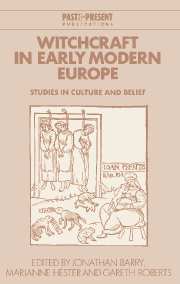Book contents
- Frontmatter
- Contents
- Preface
- Contributors
- 1 Introduction: Keith Thomas and the problem of witchcraft
- PART 1 THE CRIME AND ITS HISTORY
- 2 ‘Many reasons why’: witchcraft and the problem of multiple explanation
- 3 Witchcraft studies in Austria, Germany and Switzerland
- 4 State-building and witch hunting in early modern Europe
- PART 2 WITCHCRAFT AND RELIGION
- PART 3 THE MAKING OF A WITCH
- PART 4 WITCHCRAFT AND THE SOCIAL ENVIRONMENT
- PART 5 DECLINE
- Index
- Past and Present Publications
3 - Witchcraft studies in Austria, Germany and Switzerland
Published online by Cambridge University Press: 06 July 2010
- Frontmatter
- Contents
- Preface
- Contributors
- 1 Introduction: Keith Thomas and the problem of witchcraft
- PART 1 THE CRIME AND ITS HISTORY
- 2 ‘Many reasons why’: witchcraft and the problem of multiple explanation
- 3 Witchcraft studies in Austria, Germany and Switzerland
- 4 State-building and witch hunting in early modern Europe
- PART 2 WITCHCRAFT AND RELIGION
- PART 3 THE MAKING OF A WITCH
- PART 4 WITCHCRAFT AND THE SOCIAL ENVIRONMENT
- PART 5 DECLINE
- Index
- Past and Present Publications
Summary
The field of witchcraft studies appears to be holding pace with innovations in scholarly communications just as well as other academic pursuits. The number of international conferences has grown considerably since the 1980s. Their conference volumes offer excellent reference points for acquainting oneself with the latest developments and research in progress throughout Europe and the rest of the world. However, a glance at the catalogue of the Pisan exhibit Bibliotheca Lamiarum or the internationally renowned journal Past and Present give the impression that nationalistic tendencies in scholarship still linger on, indeed may have even hardened in the age of ‘European Unity’.
A closer examination of witchcraft studies and their historiography reveals that this was not always the case. Long before the onset of modern conference tourism, an international forum of witchcraft studies thrived and communicated in the former language of learned discourse, Latin. For this traditional intelligentsia, it was a matter of course that Christian Thomasius (1655–1728) analysed a pan-European array of documents for his Dissertatio de origine ac progressu processus inquisitorii contra sagas. Pierre Bayle (1647–1765) constantly referred back to Thomasius' text and John Wagstaff published a commentary on Thomasius, the De crimine magiae, in 1701. And the cosmopolitan character of witchcraft studies did not end with the use of Latin as the lingua franca. Thomasius himself authorised the translation of several of his English treatises into German.
- Type
- Chapter
- Information
- Witchcraft in Early Modern EuropeStudies in Culture and Belief, pp. 64 - 95Publisher: Cambridge University PressPrint publication year: 1996
- 5
- Cited by



